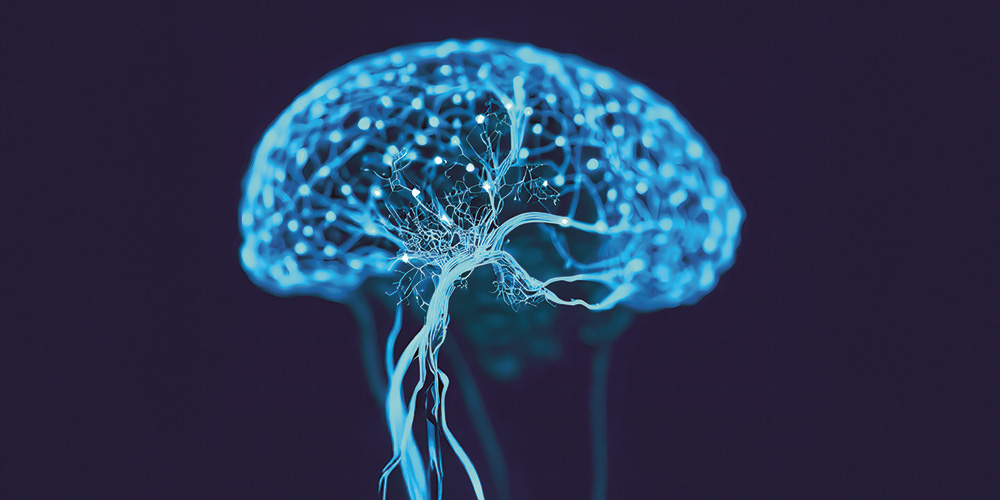Help in a technological no-man’s land.
Text: Santina Russo
Neural implants improve the lives of many — until the manufacturers stop providing support for their own technology. A researcher in medical ethics from the University of Basel is investigating the previously underestimated phenomenon of “neuroabandonment.”
Neural implants can relieve pain in migraine patients, restore blind people’s ability to see spots of light, or give people with paralyzed legs the ability to walk again. The devices interact directly with the nervous system and can alleviate neurological diseases and conditions by emitting specific electrical impulses. After all, our nervous system works on electrical signals and can therefore also be tweaked in this way.
Electrodes implanted in the brain can be used to treat symptoms of Parkinson’s disease, for example, or to predict epileptic seizures; stimulators connected to the spinal cord can relieve chronic pain; and brain-computer interfaces can partially restore patients’ motor functions or their ability to speak.
The problem is that the companies that manufacture these devices can face financial or operational difficulties and, in some cases, go bankrupt — for reasons including losing their investors, mismanagement, or because an implant doesn’t perform as intended. In the case of start-ups, this sometimes happens at the stage of clinical trials, before an implant is authorized for use in the market — but it can also happen to established companies whose devices have already been implanted in hundreds of people. In such cases, the implants are switched off or lose their ongoing technical support. What happens then?
On their own
“If people with neural implants are cut off in this way, it can be very traumatic for them,” says George Kouvas, a researcher at the Institute for Biomedical Ethics at the University of Basel. Kouvas and colleagues recently published an article in the journal Nature Medicine raising awareness of this problem and its consequences — using the term “neuroabandonment” to describe it.
“As neural implants are connected to the nervous system and often perceived as part of the body, they also affect people on an emotional level,” says Kouvas. “Much more than other therapies, the devices become part of their identities.” This makes it all the worse for patients if the implants are removed despite having significantly improved their quality of life — or if the devices are switched off or lose their ongoing support.
This is the case with the U.S. company Autonomic Technologies, which developed a promising implant for managing cluster headaches. After an initial period of expansion, the company ran out of money in late 2019. From then on, over 700 people could no longer use the software that controls their implant. One such person is Markus Möllmann-Bohle, whose implant makes the intensity of his acute pain manageable, as the 60-year-old explained in an article in the magazine Nature in 2022. As an electrical engineer, Möllmann-Bohle has so far been able to keep his device alive himself, albeit with a great deal of effort. For most users, however, the device stopped working long ago — and they are again experiencing severe pain.
Impact on identity and psyche
Another U.S. company, by the name of NeuroControl, marketed a system that was implanted in 250 people with tetraplegia to help restore hand-grasping function. Although the users were happy with the system, NeuroControl went out of business due to financial difficulties — and left the patients without ongoing technical support. That was in 2001 and it marked an early documented case of neuroabandonment. A similar situation occurred with the company Nuvectra, whose system was implanted in no less than 3,000 people and reduced their chronic pain by means of spinal cord stimulation. Ultimately, however, Nuvectra also declared bankruptcy and left its patients in a state of uncertainty.
These are just a few examples — but there are many more, and they have been compiled and analyzed by the team led by Kouvas. The researchers identified the most pressing problems and explained that the phenomenon requires urgent investigation so that appropriate action can be taken. They have already formulated a number of requirements, however, including that the risk of neuroabandonment be expressedly mentioned in the informed consent forms signed by trial participants. From the outset, manufacturers should draw up and communicate a clear exit plan from the perspective of implant recipients. “This is something that manufacturers still don’t do consistently,” says Kouvas. Across the entire sector, shared technical standards would also be helpful. This would make it easier for companies to pick up where others left off. Further measures at the political level could make it mandatory for companies to give greater thought to users of their implants.
Utilizing the potential of implants
One factor is particularly important to Kouvas: “For me, it’s not about spreading fear or skepticism — on the contrary.” As a trained electrical engineer, he has worked on the development of neural implants himself and wants to ensure that these devices can help as many people as possible. “It’s therefore vital that we also explore the ethical side and create a regulatory environment that addresses the current problems.”
In terms of the next step, Kouvas is planning a systematic exploration of the phenomenon — but he is already certain of one thing: “So far, neuroabandonment and its impact have been underestimated.” Through his work, Kouvas wants to heighten awareness of this phenomenon and pave the way for concrete, practical measures to tackle it.
Source published in Nature Medicine (2025), doi: 10.1038/s41591-025-03772-x
More articles in this issue of UNI NOVA (November 2025).

